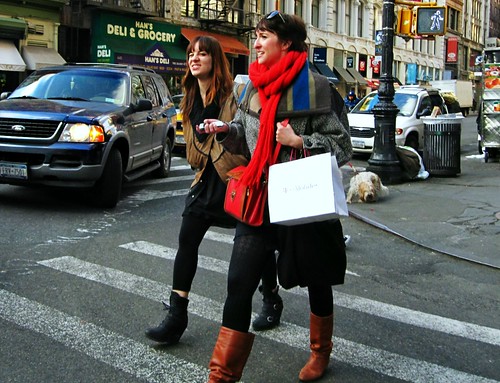For those locals who took a quick glance at accident statistics for New York City compiled by Transportation Alternatives, it probably came as little surprise that the East Village is home to two of the city’s most perilous intersections.
The intersection of Third Avenue and East 14th Street tied for the fifth most dangerous intersection in Manhattan with 66 crashes involving pedestrians from 1995 to 2005.
Bowery and West Houston Street tied for the most dangerous intersection in the entire city with 29 crashes involving cyclists.
Now that Transportation Alternatives has unveiled a plan that it believes will help make streets safer, The Local decided to pay a visit to 14th Street between Second and Third Avenues to talk to residents and business owners about the area’s dubious place as one of the city’s most treacherous stretches of asphalt.
NYU Journalism’s Claire Glass reports.
 Michelle Rick
Michelle RickIf you had to identify one defining feature of life in Manhattan, it just might be pedestrianism. There are places where calling someone or something “pedestrian” is an insult; this isn’t one of them. Here, “pedestrian” is an identity to share and be proud of. It does occasionally need defending.
Only a minority of us have cars, but every New Yorker walks and lives near things worth walking to (no matter how often we also take taxis or Zipcars or anything else). Our street grid, formed by the 1811 Commissioners’ Plan, predates the automotive invasion of American space by nearly a century. We’re the pre-automotive Americans, by design and by history as well as by inclination. And if factors like climate change, oil shortages, energy costs, Middle Eastern warfare, and rising awareness of what cars do to human bodies all suggest that the automotive era won’t last forever, we’re ready for post-automotive life, too.
On the East Side, the human/vehicular competition is particularly intense, and with the tire tracks on people’s backs to prove it, a coalition of community groups led by the nonprofit group Transportation Alternatives (along with the East Village Community Coalition, East Harlem Preservation, Civitas, Upper Green Side, and others) has developed an East Side Action Plan to define goals for the improvement of street safety involving multiple city agencies. The East Side, particularly the East Village, is a logical place for this: the area from Chinatown up to East Harlem accounts for only 8 percent of the city’s population but 22 percent of its pedestrian commuters, 13 percent of its bike commuters – and 11 percent of its “fatal and injurious” crashes.
Read more…
 Kathryn Kattalia
Kathryn KattaliaDuring the 20 years that she has lived on East Fourth Street, Frances Bush has seen dozens of accidents involving pedestrians rushing across the Bowery — a wide avenue stretching roughly a mile from Chatham Square in Chinatown to Cooper Square in the East Village.
“You have cars coming off of Houston onto Bowery and they’re going quite rapidly,” said Ms. Bush, 50. “With the construction and the bike lanes, people get confused. A lot of safety has to do with that.”
With traffic running north and south, the Bowery is one of the main arteries of the East Village. It is also one of the deadliest.
Of the 109 pedestrians hit and killed on Manhattan’s streets between 2007 and 2009, seven fatalities took place on the Bowery, making it the fourth most dangerous road for pedestrians in the borough, according to a newly released report by the Tri-State Transportation Campaign.
For a longtime Bowery observer like Ms. Bush, that comes as no surprise.
“People don’t abide by the law,” she said. “They don’t follow the lights, they don’t follow directions. It gets real crowded here and people get distracted.”
Read more…
 Michelle Rick
Michelle RickGood morning, East Village.
There’s been a lot of activity in recent days around the subject of transportation and pedestrian safety in the neighborhood and we begin this morning by taking a closer look at some of the recent coverage. DNAinfo has an informative post about five surveillance cameras that have been installed along the M15 bus route on First and Second Avenues.
The cameras will be used to help enforce a ban against vehicles riding in the lanes (exceptions are made for right turns and picking up or dropping off passengers) and drivers are subject to a fine between $115 and $150. Bowery Boogie posted a photo of a group cyclists towing rolling billboards to publicize the violations.
The benefits and drawbacks of bike lanes, a source of much debate in the neighborhood, is the subject of a piece in The Times. And over at City Room, they want to hear from readers – few New Yorkers are as well-versed in this issue as we are here in the neighborhood so go ahead and weigh in.






